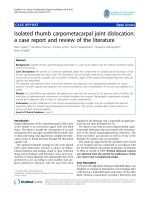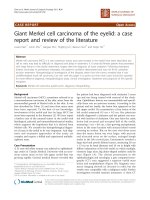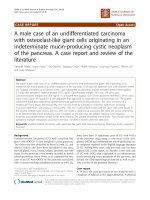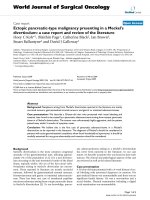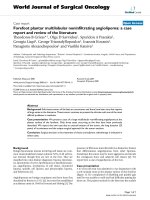Báo cáo y học: " Acinic cell carcinoma in pregnancy: a case report and review of the literature" docx
Bạn đang xem bản rút gọn của tài liệu. Xem và tải ngay bản đầy đủ của tài liệu tại đây (565.37 KB, 4 trang )
CAS E REP O R T Open Access
Acinic cell carcinoma in pregnancy: a case report
and review of the literature
Nabil N Al-Zaher
*
, Amani A Obeid
Abstract
Introduction: We report an observational study on the etiology and recurrence of acinic cell carcinoma of the
parotid gland that seemed to be related to pregnancy. The medical literature has never reported such an
association; therefore, our case report is probably the first to mention this observation.
Case presentation: This report is of a 25-year-old Arabic female patient from the United Arab Emirates, who,
during her first pregnancy, developed acinic cell carcinoma of the right parotid gland that was managed with
surgical excision in the form of superficial parotidectomy. During her second pregnancy, which occurred four years
later, she had a recurrence of the same malignant neoplasm associated with ipsilateral malignant cervical
lymphadenopathy. The patient was managed with total parotidectomy and neck dissection, as well as
postoperative adjuvant radiotherapy. Our observatio n on this particular case of acinic cell carcinoma is that the
initial onset of her neoplasm was during her first pregnancy, and the recurrence of the same malignant disease
was during a subsequent pregnancy. This chronologic association raised our suspicion that there might be a
possible etiologic effect of pregnancy or its associated hormonal or physiologic changes or both on the
pathogenesis or etiology of acinic cell carcinoma.
Conclusion: Some association might exist between pregnancy and the pathogenesis or etiology of acinic cell
carcinoma.
Introduction
Acinic cell carcinoma (ACC) is a rare malignant epithe-
lial salivary neoplasm of a ductal cell origin. It is a low-
grade malignancy that most often occurs in the parotid
gland and presents at a relatively younger age than
other salivary gland tumors. This malignant disease
shows a female predilection, and it represents the third
most comm on epithelial mal ignancy of the salivary
glands in adults [1].
Possible causes of ACC include previous radiation
exposure [2] and familial predisposition [3,4]. Women
are more apt to have this malignant neoplasm, and
endogenous hormones have been reported in normal
and neoplastic salivary glands, but some of the results
have been conflicting. Estrogen receptors have been
reported in a minority of cases of ACC, mucoepider-
moid carcinoma, and salivary duct carcinoma [1].
Progesterone receptors and androgen receptors were
also seen in some cases of ACC. These findings raised
suspicion that some of the salivary gland neoplasms,
including ACC, might be hormonall y dependent, like
breast carcinoma [1,5]. The medical literature that we
thoroughly reviewed had no mention of effect of preg-
nancy on the development or the recu rrence of this
malignant neoplasm we observed in this case.
Case presentation
A 25-year-old Arabic female patient from the United
Arab Emirates developed a right parotid mass lesion
that was otherwise completely asymptomatic and of a
stable size. She had no history of head and neck radia-
tion treatment or a persona l or fami ly history of salivary
neoplasms, but she was in the second trimester of her
first pregnancy. Initially, the patient did not seek medi-
cal attention, but because of the progressive increase of
the size of her parotid mass lesion, she obtained a refer-
ral to a head and neck surgeon. Her medical assessment,
* Correspondence:
MBC 47, Department of Otolaryngology, Head & Neck Surgery and
Communication Disorders, King Faisal Specialist Hospital & Research Centre,
P.O. Box 3354, Riyadh 11211, Kingdom of Saudi Arabia
Al-Zaher and Obeid Journal of Medical Case Reports 2011, 5:91
/>JOURNAL OF MEDICAL
CASE REPORTS
© 2011 Al-Zaher and Obeid; licensee BioMed Central Ltd. This is an Open Access article distributed under the terms of the Creative
Commons Attribution License (http://creativecom mons.org/licenses/by/2.0), which permits unr estricted use, distribution, and
reprodu ction in any medium, provided the original work is properly c ited.
which included cytologic studies, indicated that the mass
lesion was due to an acinic cell carcinoma.
The patient was managed surgically in the form of a
right superficial parotidectomy with pres ervation of the
ipsilateral facial nerve.
The patient remained well and had no recurrence of
her malignant disease until four years later, when she
became pregnant again. During the third trimester of her
pregnancy, she developed a new mass lesion at the same
sit e as her prev ious paroti dectomy, which pro ved to be a
recurrent acinic cell carcinoma . She also had a right sub-
man dibu lar maligna nt lymphadenopa thy. The size of the
rec urrent acinic cell carcinoma and the ipsilateral malig-
nant cervical lymphadenopathy progressively increased
until the end of her pregnancy. The function of both
facial nerves was intact. All investigations were essentially
unremarkable, and no evidence of distant metastases or
contraindications for surgical treatment were present.
Her CT scan confirmed the presence of the recurrent
mass lesion of the right parotid gland (Figure 1).
The multidisciplinary management of this patient con-
sisted of a right total parotidectomy with preservation of
the facial nerve (Figure 2) and an ipsilateral radical neck
dissection followed by postoperative external-beam
radiotherapy. The final histopathologic assessment con-
firmed the diagnosis of acinic cell carcinoma (Figure 3).
The patient recovered from her treatment and was sub-
sequently managed with close surveillance. Her disease
has been well controlled until the time of this report, and
she has had no recurrence of her acinic cell carcinoma.
Discussion
Acinic cell carcinoma (ACC) is a rare malignant epithe-
lial salivary neoplasm of a ductal cell origin. It is a low-
grade malignancy that most often occurs in the parotid
gland and presents at a relatively younger age than
other salivary gland tumors. This malignant disease
shows a female predilection [1].
Acinic cell carcinoma constitutes approximately 17%
of primary sali vary gland malignancies, representing the
Figure 1 An axial CT-scan image confirming the presence of a
solid mass lesion (acinic cell carcinoma) within the right
parotid gland.
Figure 2 An intraoperative view of the patient’ sright
parotidectomy that clearly demonstrates the facial nerve that
was identified and preserved intact.
Figure 3 H&E-stained pathology slide (40×). The neoplasm
(acinic cell carcinoma) is encapsulated (arrow) and consists of
clusters of malignant cells forming acini. The malignant cells
themselves are pleomorphic and have atypical nuclei.
Al-Zaher and Obeid Journal of Medical Case Reports 2011, 5:91
/>Page 2 of 4
third most common epithelial malignancy of the salivary
glands in adults, and in the pediatrics age group, it is
considered to be the second most common epithelial
salivary malignancy a fter mucoepidermoid carcinoma.
Women are usually more frequently diagnosed (58.8%)
than men (41.2%), and according to the National Cancer
Data Base Report on cancer of the head and neck, the
parotid gland was the predominant site of origin (86.3%)
for reported acinic cell carcinomas [5].
Possible causes of ACC include previous radiation
exposure [2] and familial predisposition [3,4]. Women
are more apt to have this malignant neoplasm, and
endogenous hormones have been reported in normal
and neoplastic salivary glands, but some of the results
have been conflicting. Estrogen receptors have been
reported in a minority of cases of ACC, mucoepider-
moid carcinoma, and salivary duct carcinoma [1]. Pro-
gesterone receptors and androgen receptors were also
seen in some cases of ACC. These findings raised suspi-
cion that some of the s alivary gland neoplasms, includ-
ing ACC, might be hormonally dependent, like breast
carcinoma [1,5]. The current medical literature that we
thoroughly reviewed had no mention of the effect of
pregnancy on the development or the recurrence of this
malignant neoplasm, which we observed in this case.
Interestingly, the carcinoma of this patient initially
appeared during her first pregnancy, and it recurred
during a subsequent pregnancy a few years later. The
observed chronologic association raised our suspicion
about a possible etiologic relation between pregnancy
and ACC. Our observation might open doors for similar
or other observations that would improve our under-
standing of this malignant disease and its management.
Parotid ACC typically presents with a slowly enlarging
mass in the parotid region. Spiro et al. [6] found that
34.33% to 50.75% were palpated in the tail of the parotid
gland. Pain (7.46%) and facial nerve palsy (3%) were sel-
dom reported.
ACC has a significant tendency to recur, to produce
metastases (cervical lymph nodes and lungs), and may
have an aggressive evolution [7].
The genetic alterations linked to ACC of the parotid
gland include alterations at chromosomes 4p, 5q, 6p,
and 17p, suggesting the association of tumor- suppressor
genes with the oncogenesis of these tumors [8,9].
ACC is histologically defined by serous acinar cell dif-
ferentiation. However, seve ral cell types and histomor-
phologic growth patterns are recognized [6,10-15].
The diagnosis of ACCs frequently presents difficulties,
owing t o its great r adiologic [16,17] and cytologic simi-
larity with b enign tumors and with the normal acinar
component of the salivary gland, respectively.
Fine-needle aspiration biopsy (FNAB) has been well
established in the diagnosis of salivary gland lesions, as
it provides essential information on the diagnostic and
therapeutic management of these tumors; this method is
highly sensitive in its diagnostic efficacy. The cytologic
findings in FNABs of ACCs are usually characterized by
acinar differentiated tumor cells and by certain
cytoarchitectural patterns [18,19].
In addition to FNAB and other ancillary diagnostic tests,
imaging s tudies are usually used in the pretreatment
assessment and management planning of ACC, which
might include ultrasonography, computed tomography,
magnetic resonance imaging, and nuclear scans [17].
In general, management of ACC consists of complete
surgical removal of the tumor, by total or subtotal paroti-
dectomy, and postoperat ive radiotherapy may sometimes
be indicated, as was the case with this patient [3,5].
The overall five-year disease-specific survival is esti-
matedtobearound91%,and88%at10years[20].
Because of the relatively high tendency of ACC to recur
and to produce latent metastases, long-term follow-up is
mandatory after treatment [4,5].
Conclusion
This observational report introduces new information
regarding the etiology or pathogenesis or both of acinic
cell carcinoma of the salivary glands, which is expected
to help in the understanding of this malignant disease
and i n its management, control, and prevention b y sur-
geons and oncologists.
Consent
Written informed consent was obtained from the patient
for publication of this case report and the accompanying
images. A copy of the written consent is available for
review by the Editor-in-Chief of this journal.
Authors’ contributions
NNAZ was involved in patient evaluation and management. He is the
primary author. He was the supervising surgeon of the case, and he
participated in the editing of the article and in reviewing the literature. AAO
was involved in data collection, literature review, and in editing the article.
All authors read and approved the final manuscript.
Competing interests
The authors declare that they have no competing interests.
Received: 5 March 2010 Accepted: 4 March 2011
Published: 4 March 2011
References
1. Barnes L, Eveson JW, Reichart P, Sidransky D: World Health Organization
Classification of Tumours: Pathology and Genetics of Head and Neck Tumours
Lyon: IARC Press; 2005.
2. Chou C, Zhu G, Luo M, Xue G: Carcinoma of the minor salivary glands:
results of surgery and combined therapy. J Oral Maxillofac Surg 1996,
54:448-453.
3. Kane WJ, McCaffrey TV, Olsen KD, Lewis JE: Primary parotid malignancies:
a clinical and pathologic review. Arch Otolaryngol Head Neck Surg 1991,
117:307-315.
Al-Zaher and Obeid Journal of Medical Case Reports 2011, 5:91
/>Page 3 of 4
4. Federspil PA, Constantinidis J, Karapantzos I, Pahl S, Markmann HU, Iro H:
Acinic cell carcinomas of the parotid gland: a retrospective analysis.
HNO 2001, 49:825-830.
5. Hoffman HT, Karnell LH, Robinson RA, Pinkston JA, Menck HR: National
Cancer Data Base report on cancer of the head and neck: acinic cell
carcinoma. Head Neck 1999, 21:297-309.
6. Spiro RH, Huvos AG, Strong EW: Acinic cell carcinoma of salivary origin: a
clinicopathologic study of 67 cases. Cancer 1978, 41:924-935.
7. Zbären P, Schreiber B, Lehmann W, Widgren S: Acinar cell carcinoma of
the salivary glands. Laryngol Rhinol Otol (Stuttg) 1987, 66:320-323.
8. El-Naggar AK, Abdul-Karim FW, Hurr K, Callender D, Luna MA, Batsakis JG:
Genetic alterations in acinic cell carcinoma of the parotid gland
determined by microsatellite analysis. Cancer Genet Cytogenet 1998,
102:19-24.
9. Sandros J, Mark J, Happonen RP, Stenman G: Specificity of 6q- markers
and other recurrent deviations in human malignant salivary gland
tumors. Anticancer Res 1988, 8:637-643.
10. Batsakis JG, Luna MA, El Naggar AK: Histopathologic grading of salivary
gland neoplasms, II: acinic cell carcinomas. Ann Otol Rhinol Laryngol 1990,
99:929-993.
11. Ellis GL, Auclair PL: Tumours of the Salivary Glands. 3 edition. Washington:
Armed Forces Institute of Pathology; 1996.
12. Lewis JE, Olsen KD, Weiland LH: Acinic cell carcinoma: clinico-pathologic
review. Cancer 1991, 67:172-179.
13. Shet T, Ghodke R, Kane S, Chinoy RN: Cytomorphologic patterns in
papillary cystic variant of acinic cell carcinoma of the salivary gland. Acta
Cytol 2006, 50:388-392.
14. Seifert G: Histopathology of malignant salivary gland tumors. Eur J Cancer
B Oral Oncol 1992, 28B:49-56.
15. Seifert G, Sobin LH: Histological Typing of Salivary Gland Tumours. 2 edition.
Berlin: Springer-Verlag; 1996.
16. Som PM, Bergeron RT: Salivary Gland: Head and Neck Imaging St. Louis:
Mosby Year Book; 1991, 277-348.
17. Sakai O, Nakashima N, Takata Y, Furuse M: Acinic cell carcinoma of the
parotid gland: CT and MRI. Neuroradiology 1996, 38:675-679.
18. Nagel H, Laskawi R, Büter JJ, Schröder M, Chilla R, Droese M: Cytologic
Diagnosis of acinic-cell carcinoma of salivary glands. Diagn Cytopathol
1997, 16:402-412.
19. Alphs HH, Eisele DW, Westra DH: The role of fine needle aspiration in the
evaluation of parotid masses. Curr Opin Otolaryngol Head Neck Surg 2006,
14:62-66.
20. Wahlberg P, Anderson H, Biorklund A, Moller T, Perfekt R: Carcinoma of the
parotid and submandibular glands: a study of survival in 2465 patients.
Oral Oncol 2002, 38:706-713.
doi:10.1186/1752-1947-5-91
Cite this article as: Al-Zaher and Obeid: Ac inic cell carcinoma in
pregnancy: a case report and review of the literature. Journal of Medical
Case Reports 2011 5:91.
Submit your next manuscript to BioMed Central
and take full advantage of:
• Convenient online submission
• Thorough peer review
• No space constraints or color figure charges
• Immediate publication on acceptance
• Inclusion in PubMed, CAS, Scopus and Google Scholar
• Research which is freely available for redistribution
Submit your manuscript at
www.biomedcentral.com/submit
Al-Zaher and Obeid Journal of Medical Case Reports 2011, 5:91
/>Page 4 of 4
